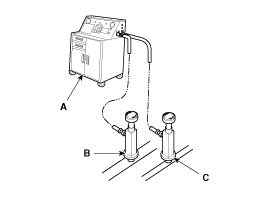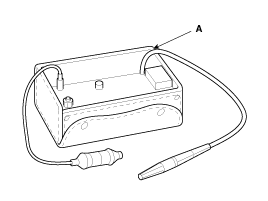 Kia Sorento: Refrigerant Recovery
Kia Sorento: Refrigerant Recovery
Use only service equipment that is U.L-listed and is certified to meet
the requirements of SAE J2210 to remove HFC-134a(R-134a) from the air conditioning
system.
|
If accidental system discharge occurs, ventilate the work area before
resume of service.
Additional health and safety information may be obtained from the refrigerant
and lubricant manufacturers.
| 1. |
Connect a R-134a refrigerant
Recovery/Recycling/Charging system (A) to the high-pressure service
port (C) and the low-pressure service port (B) as shown, following the
equipment manufacturer's instructions.
|
| 2. |
Measure the amount of refrigerant oil removed from the A/C system
after the recovery process is completed. Be sure to install the same
amount of new refrigerant oil back into the A/C system before charging.
|
System Evacuation
Use only service equipment that is U.L-listed and is certified to meet
the requirements of SAE J2210 to remove HFC-134a(R-134a) from the air conditioning
system.
|
If accidental system discharge occurs, ventilate the work area before
resume of service.
Additional health and safety information may be obtained from the refrigerant
and lubricant manufacturers.
| 1. |
When an A/C system has been opened to the atmosphere, such as
during installation or repair, it must be evacuated using a R-134a refrigerant
Recovery/Recycling/Charging system. (If the system has been open for
several days, the receiver/drier should be replaced, and the system
should be evacuated for several hours.)
|
| 2. |
Connect a R-134a refrigerant Recovery/Recycling/Charging system
(A) to the high-pressure service port (B) and the low-pressure service
port (C) as shown, following the equipment manufacturer's instructions.
|
| 3. |
If the low-pressure does not reach more than 93.3 kPa (700 mmHg,
27.6 in.Hg) in 10 minutes, there is probably a leak in the system. Partially
charge the system, and check for leaks (see Refrigerant Leak Test.)
|
| 4. |
Remove the low pressure valve from the low-pressure service port.
|
System Charging
Use only service equipment that is U.L-listed and is certified to meet
the requirements of SAE J2210 to remove HFC-134a(R-134a) from the air conditioning
system.
|
If accidental system discharge occurs, ventilate the work area before
resume of service.
Additional health and safety information may be obtained from the refrigerant
and lubricant manufacturers.
| 1. |
Connect a R-134a refrigerant
Recovery/Recycling/Charging system (A) to the high-pressure service
port (B) as shown, following the equipment manufacturer's instructions.
|
| 2. |
Add the same amount of new refrigerant oil to the system that
was removed during recovery. Use only specified refrigerant oil. Charge
the system with [Front only: 600┬▒25g (21.1┬▒0.88oz.), Front & Rear: 750┬▒25g
(26.4┬▒0.88oz.)] R-134a refrigerant. Do not overcharge the system the
compressor will be damaged.
|
Refrigerant Leak Test
Always conduct a leak test with an electronic leak detector whenever leakage
or refrigerant is suspected and when conducting service operations which are
accompanied by disassembly or loosening or connection fittings.
In order to use the leak detector properly, read the manual supplied
by the manufacturer.
|
If a gas leak is detected, proceed as follows:
| 1. |
Check the torque on the connection fittings and, if too loose,
tighten to the proper torque. Check for gas leakage with a leak detector
(A).
|
| 2. |
If leakage continues even after the fitting has been tightened,
discharge the refrigerant from the system, disconnect the fittings,
and check their seating faces for damage. Always replace, even if the
damage is slight.
|
| 3. |
Check the compressor oil and add oil if required.
|
| 4. |
Charge the system and recheck for gas leaks. If no leaks are found,
evacuate and charge the system again.
|
 Component Location
Component Location
[Engine Room]
1. Receiver-drier
2. Condenser
3. Ambient temperature Sensor
4. Compressor
5. Discharge Hose
6. Suction & Liquid Tube Assembly
7. Servic ...
See also:
Closing the tailgate
To close the tailgate, lower and push down the tailgate firmly. Make sure that
the tailgate is securely latched.
WARNING
Make sure your hands, feet and other parts of your body are safely out of
...
2. TCM terminal function
Connector [A]
Pin
Description
Pin
Description
1
-
45
Inhibitor switch signal 'S2'
2
-
46
Inh ...
Inspection
Test the horn by connecting battery voltage to the 1 terminal and ground
the 2 terminal.
The horn should make a sound. If the horn fails to make a sound, replace
it.
Horn Relay Inspec ...
Copyright ® www.ksmanual.com 2014-2025







